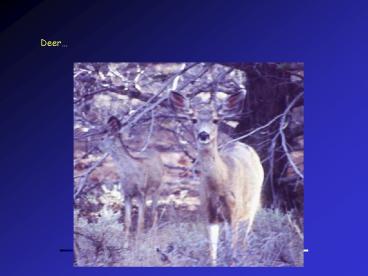Concepts of Vertebrate Pest Management PowerPoint PPT Presentation
1 / 46
Title: Concepts of Vertebrate Pest Management
1
Deer
2
Biology
- 2 years to sexual maturity
- Mating season October November
- Gestation period 195 212 days
- 1 4 young (average 2)
- 1 year between births
- Average lifespan 10 years
3
Behavior
- Mostly nocturnal
- Social
- Browsers
4
Damage
5
(No Transcript)
6
Management options
- Habitat modification
- Exclusion
- Repellents
- Scare devices
- Shooting
7
DEER RESISTANT PLANTS.
PerennialsAllium(Onions)Althea(Hollyhock)Anemon
es(Windflower)AubrietiaBerlandiera(Chocolate
Flower)Cerastiim(Snow-in-Summer) CoreopsisDigita
lis(Foxglove)EpimediumHelianthus(Sunflower)Iris
(Bearded Iris)Lamium(Dead Nettle)Papaver(Poppy)
Ratibida(Prairie Coneflower) Rudbeckia(Black-eyed
Susan)Solidago (Fireworks Goldenrods)Sphaeralce
a (Orange Globe Mallow) Stachys
(Lamb's-ears)Vinca (Myrtle) Zauschneria
(Hummingbird Flower)
Solidago(Golden Fleece)
Petalostemon(Prairie Clover)
8
DEER RESISTANT PLANTS.
Herbs Anthum graveolens (Dill)Mentha(Mint)
Chamaebatiera (Fernbush)
Shrubs Trees Berberis(Barberry)Buddleia Colone
asterCerocarpus (Mahogany)Forsythia Juniperus
(Juniper)Picea (Spruce)Potentilla
(Cinquefoil)Syringa (Common Lilac)
Mahonia (Oregon Grape)
9
Exclusion
10
8 x 165 Heavy Perimeter Fence 189.00 9 Heavy
Duty Post 19.75
11
High tensile electric fence
High tensile woven fence 8 x 330 319.00
12
Repellents
13
Products that repel by Smell Taste Smell and
taste
14
(No Transcript)
15
(No Transcript)
16
(No Transcript)
17
(No Transcript)
18
Relative effectiveness.
Score Repellent 3.0 Big Game Repellent (putres.
eggs) 2.3 Hinder (ammon. soaps - fatty
acids) 2.0 thiram 1.4 Hot Sauce Animal
Repellent (capsaicin) 0.0 Ro-Pel (denatonium
saccharide) A. El Hani and M. R. Conover (1995)
19
Home remedies
Human hair Garlic Soap Rotten egg mixture Etc.
20
Factors that Influence Effectiveness.
- concentration of repellent
- palatability
- animal numbers (population size)
- alternate food choices
- size of treated area
- habituation
21
Scare devices
Must be Saturday night again
22
Shooting
Depredation permit from DFG required outside
hunting season
23
Raccoon.
- 23 - 41 inches long
- Weigh up to 40 lb
- Occupies all habitats except alpine and deserts
without water.Dens in tree cavities, snags,
logs, rocky areas, and buildings. - Active during throughout the year
- Diet animal matter (spring)
- grains, acorns, other nuts, and fruits (summer
and fall) - Home range 210 to 940 ac.
- Males territorial towards other males
24
Raccoon.
- Breed January - March. (1 litter per year
only) - Gestation period 54 to 65 days.
- Young born March May
- Litter size 1 8
- Young weaned between 60 and 90 days and become
somewhat independent by about 130 days.
25
Management.
Trapping Wire mesh trap (10x12x30
inches). Scattered bait on the trail leading up
to the trap. Check traps at least once a day.
Exclusion Secure containers with tight-fitting
lids Electric fence 2-wires spaced 15 cm and
30 cm above the ground.
26
Other furry friends.
- Nongame mammals
- Opossum
- Skunk
- Mice and Rats
- Game mammals
- Tree squirrel
- Jackrabbit
- Cottontail
27
Birds
28
Species
Native American crow Scrub jay Swallow Blackbird F
inch Woodpecker Sapsucker
Non-native Starling English house sparrow Pigeon
29
Bird Identification ..
30
Bird damage.
- Buds
- Fruit
- Tree trunks and branches
- Sprinklers
- Structures
31
Management techniques
Hazing (scaring) Habitat modification Exclusion Re
pellents Lethal control (shooting, trapping)
32
Hazing
Visual
Noise
33
Habitat modification
Removal of cover or food resources
34
Exclusion
35
Repellents and flock dispersants.
36
Lethal control
Many birds protected by Migratory Bird Treaty
Act USFWS depredation permit usually needed for
lethal control of native birds No permit
required for lethal control of non-native birds
37
Laws you should know
38
Trapping
39
Swallows
40
Damage
41
Biology
- Insectivorous
- Catch prey on the wing
- 5 6 inches long
- Cliff swallow has a square tail
- Barn swallow has a forked tail
42
Behavior
- Spend winter in South America
- Appear in CA in Feb Mar
- Require 1. Open habitat for foraging 2.
Vertical surface beneath an overhang for nest 3.
Mud supply 4. Fresh water supply - Lay eggs before nest is complete (3 4 eggs
laid) - Will rebuild nest if it is destroyed
43
Management options
- Do nothing
- Exclusion
44
Fertility control
Many limitations
- delivery methods
- high cost
- non-target effects
- poor understanding of ecological effects
45
Will it work?
- Nonlinear relationship between proportion
sterilized and reduction in population density
46
Good vertebrate pest management.
- Know the potential problems
- Alter the habitat (if possible) to minimize the
damage potential - Monitor for the pest species and damage
- Take cost-effective action if necessary
- Follow-up evaluation
- Continue monitoring

